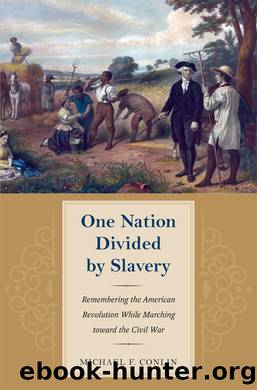One Nation Divided by Slavery by Michael Conlin

Author:Michael Conlin [Conlin, Michael]
Language: eng
Format: epub
Tags: Nonfiction, History, Americas, United States, Revolutionary Period (1775-1800)
ISBN: 9781631011160
Publisher: The Kent State University Press
Published: 2015-11-13T05:00:00+00:00
5
Finishing What the Founders Started
Antebellum Americans were devoted to the Revolution. They mourned the passing of rank-and-file Revolutionaries. They apotheosized the leading Revolutionaries. They revered the leading Revolutionariesâ descendants (and even their friends). They made pilgrimages to Revolutionary battlefields. They erected monuments to the men, battles, documents, and ideas that marked the progress of the Revolution. They thronged the shrines that held the relics of the Revolution. While the Revolution brought Americans together, it also divided them. At the same time Americans shared a common reverence for the Revolution, they quarreled over exactly what it was. By the mid-1840s, this quarrel intensified and became sectional. As historian Michael Morrison observes: âincreasingly the nation was unable either to recapture the spirit or to agree on the essence of their Revolution.â Indeed, this struggle over the meaning and legacy of the Revolution was both a controversy in the sectional conflict and an exercise in national myth-making. While Southern hotspurs emphasized the Revolutionary legacy of self-determination and resistance to encroachment on individual rights, slaves, abolitionists, and some Free-Soilers looked to the Revolutionary legacy of natural rights for all, and sectional moderates in the North and the South took pride in the notion that the common sacrifice of the Patriots in the North and the South had bestowed a Revolutionary legacy of individual liberty that made the slaveholding United States the most free nation on earth. By the 1850s, fire-eaters and fugitive slaves invoked the right to rebellionâto different endsâwhile at the same time moderates tried to keep the fire of the old Revolution alight while smothering that of the new. As historians Elizabeth Fox-Genovese and Eugene Genovese noted, the âmore pronounced the quarrel over slavery, the more important the interpretation of the Revolution becameâ to Americans in the North and the South.1
Perhaps no legacy of the Revolution put the issue of slavery in American nationality in bolder relief than Northern emancipation. If slavery was an essential component of American nationalism, if all original thirteen states had once been âSlave States,â then how to explain the decision by the worthies of the Revolution to abolish it, in some cases even before independence itself was won? At the same time, the persistence of slavery in the Southern half of the new nation raised its own questions. All antebellum Americans acknowledged that the Founders had established a union of thirteen slave states in 1776. As the Anti-Slavery Bugle observed, when the original thirteen had declared independence, âslaves were held, to a greater or lesser extent, in every one of them.â Making the same point from the other side of the slavery divide, the Delaware State Reporter cautioned Northerners to remember that slavery âexisted originally in all the States, and not just the South only.â But their agreement on that historical fact only served to focus their conflict on what came next. Seven of the original thirteen slave states freed their chattels, while nine more slave states joined the remaining six original slave states in the Union.2
Just
Download
This site does not store any files on its server. We only index and link to content provided by other sites. Please contact the content providers to delete copyright contents if any and email us, we'll remove relevant links or contents immediately.
| United States | Abolition |
| Campaigns & Battlefields | Confederacy |
| Naval Operations | Regimental Histories |
| Women |
In Cold Blood by Truman Capote(3343)
The Innovators: How a Group of Hackers, Geniuses, and Geeks Created the Digital Revolution by Walter Isaacson(2976)
Steve Jobs by Walter Isaacson(2854)
All the President's Men by Carl Bernstein & Bob Woodward(2344)
Lonely Planet New York City by Lonely Planet(2189)
And the Band Played On by Randy Shilts(2163)
The Room Where It Happened by John Bolton;(2132)
The Poisoner's Handbook by Deborah Blum(2108)
The Murder of Marilyn Monroe by Jay Margolis(2074)
The Innovators by Walter Isaacson(2073)
Lincoln by David Herbert Donald(1962)
A Colony in a Nation by Chris Hayes(1898)
Being George Washington by Beck Glenn(1769)
Under the Banner of Heaven: A Story of Violent Faith by Jon Krakauer(1763)
Amelia Earhart by Doris L. Rich(1668)
The Unsettlers by Mark Sundeen(1658)
Dirt by Bill Buford(1647)
Birdmen by Lawrence Goldstone(1636)
Zeitoun by Dave Eggers(1612)
